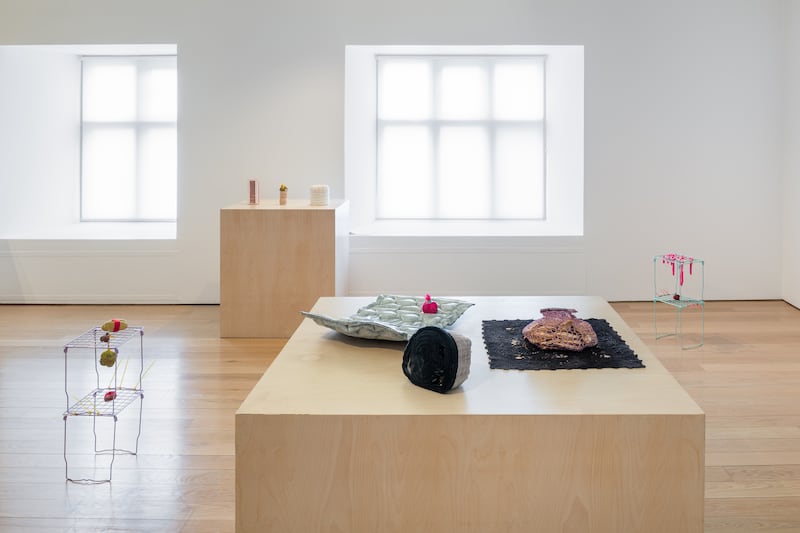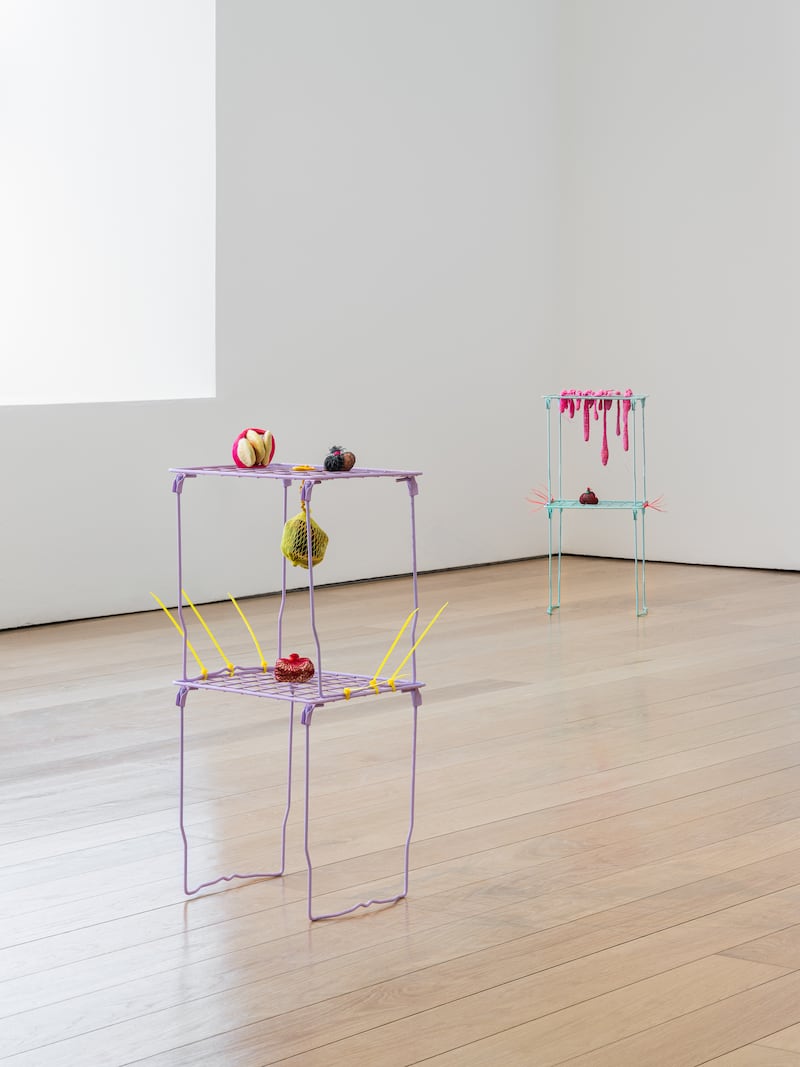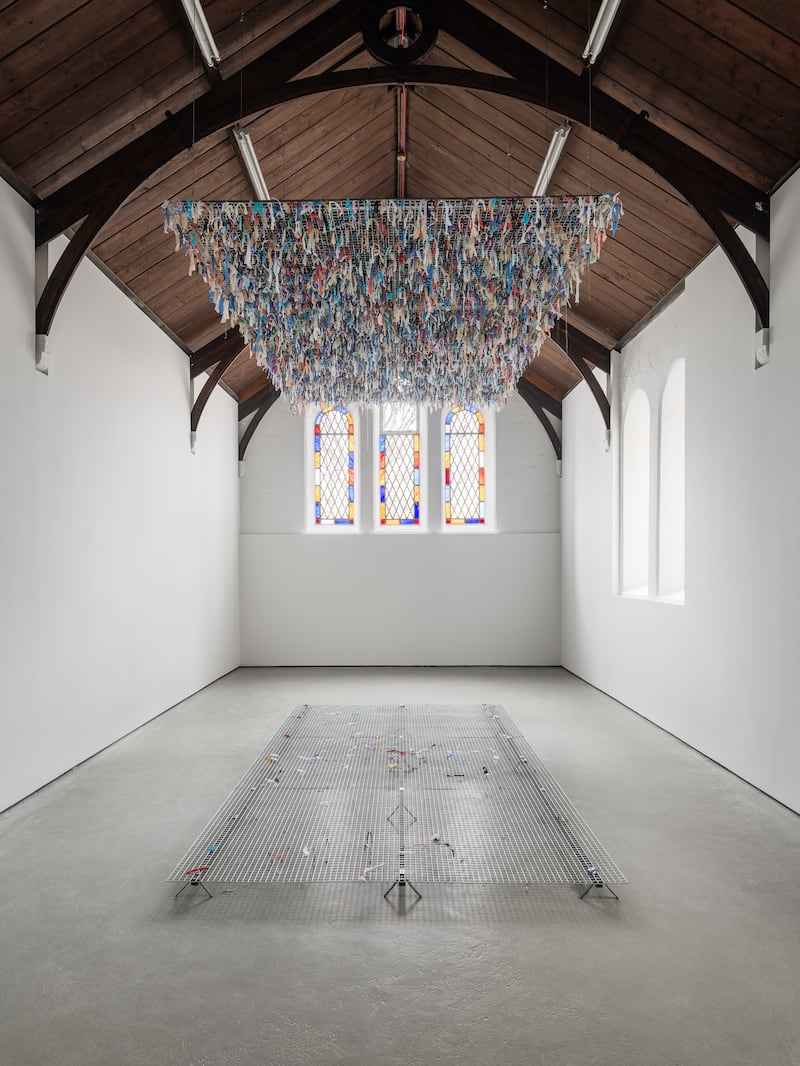Each Now, Is the Time, the Space: Leonor Antunes, Alexandre da Cunha, Rhea Dillon, Veronica Ryan
Aleana Egan: Second-hand
Lismore Castle Arts and St Carthage Hall, Lismore, Co Waterford
★★★☆☆
Rhea Dillon beautifully plays with ideas of dislocation and disconnection. At Lismore Castle Arts, C/leaning Figures (2023) is a series of four wall-mounted brown plaques, with the look of cut crystal dishes. Below are four piles of crystal platters. Except they’re not. Made from soap, molasses and resin, and gently scented, they are softening, imperceptibly losing shape and substance over time. Beside this is one part of Sole Responsibility: Aged 12, but above V (2023); real cut crystal, shaped from the sole of a foot. Opposite is another, and together they represent black experiences of generations, fragile, displaced and separated by transportation and migration, by UK Government policy, as well as by time.
Cut crystal is a feature of Caribbean diaspora households, molasses speaks of plantation, and throughout the exhibition, materials matter. Everything has significance, or does it? Curator Habda Rashid, of Cambridge’s Fitzwilliam Museum, writes of unfixing meaning, but the ultimate results here mean this fascinating show loses its riches by being too elusive. It is as if secrets are being kept, rather than revealed.


Possibly best known, on these shores at least, Montserrat-born, and UK-based Veronica Ryan won the Turner Prize in 2022, partly for her three large pieces of public sculpture in Hackney, London, modelled on breadfruit and its ilk, and commissioned to commemorate the Windrush generation of migrants to the UK. At Lismore, the works are more eclectic. Brightly coloured tape, cable ties, hairnets and crochet, holding seeds, fruit stones and other objects are suspended in wire frames, or encased in plaster.
According to Rashid’s text, they are “formal emotive propositions, embedded with the fluctuating states and connections that exist between our ecological environment, history, memory and loss”. They also feel like little dream-catchers, holding the last remnants of association in place, as time sweeps away meaning; or perhaps instead like mislabelled museum artefacts, the misunderstood traces of half-forgotten people.
I absolutely dread going to my husband’s parents’ home for Christmas
Patrick Freyne’s quest for the best Christmas sandwich in Dublin: ‘I give it five Santas out of five’
‘Nobody had heard of Ireland, it was amazing. I had to explain it was beside England’
‘Startling’: First look behind the RCSI’s new ‘front door’ on St Stephen’s Green
Also on show, Alexandre da Cunha picks up on the misplaced museum vibe with a series of household items (a cake tin, brushes, a fan blade, a flip-flop) held in concrete, or preserved in a bottle – like a scientific specimen. Sophie, Leonor Antunes’s series of wood and metal frame-like sculptures, hung with beaded drapes, is said to reference Swiss artist Sophie Taeuber-Arp. But proving there probably is nothing new under the sun, it finds a more visual connection with Niamh O’Malley’s permanent installation in the Stable Yard at Lismore Castle, which formed part of the artist’s Irish pavilion at the 2022 Venice Biennale.

Across the road at St Carthage Hall, Aleana Egan’s Second-hand is another opaque installation including metal grids, cloth strands and unspooled audio tape. Interestingly, given a space all to itself, the enigma becomes delicious and rewarding. Strong group shows can create brilliant conversations, and there is an argument that knowledge hard-won is more deeply absorbed, but unless already familiar with the wider work and context of these artists, you may well need a little more help to get in, and under the skin of this one.
Each Now, Is the Time, the Space runs until October 27th; Second-hand runs until May 19th; both at Lismore Castle Arts, Lismore, Co Waterford















